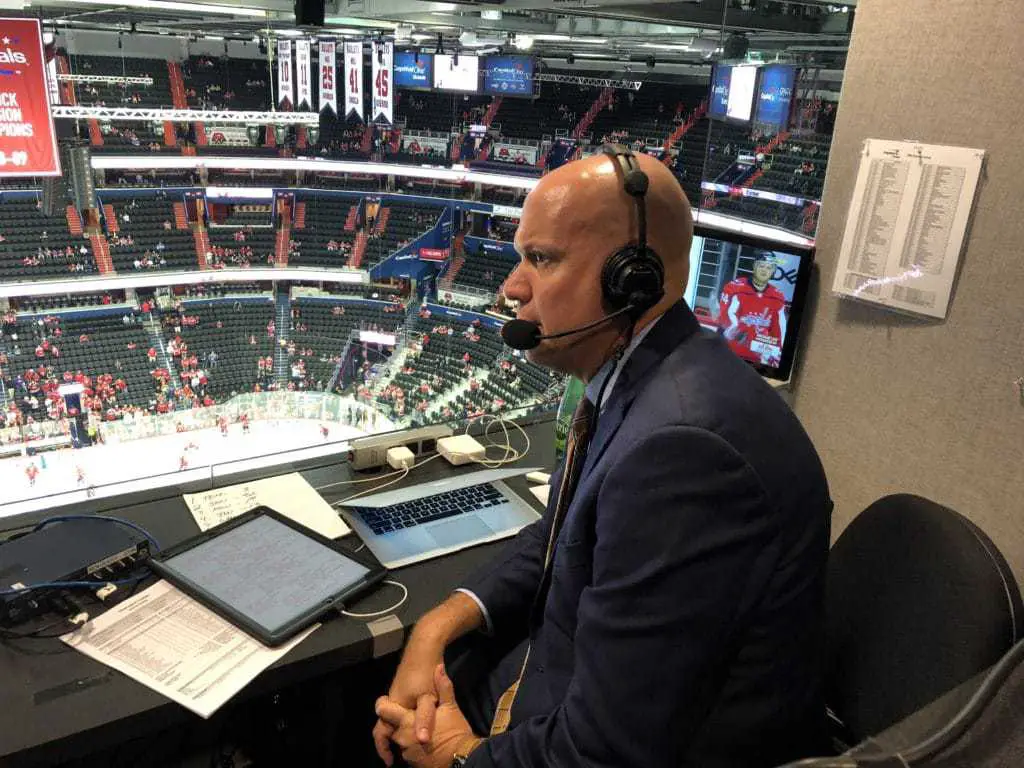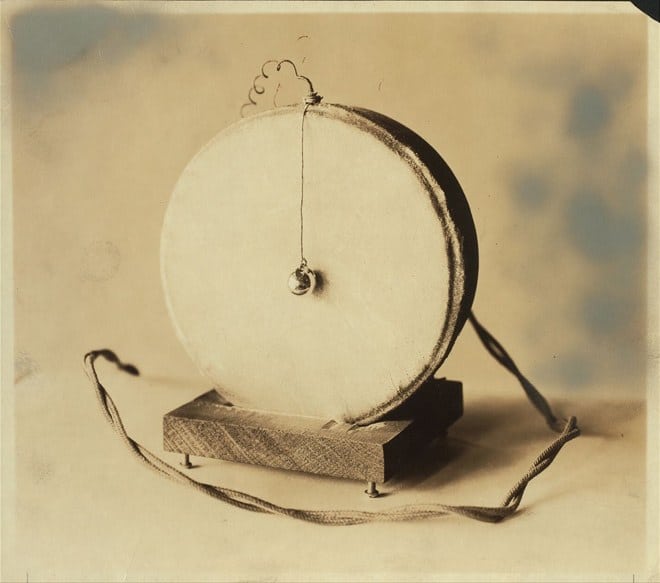
In the early ’20s, radio stations were born many were owned by retailers and newspaper owners. the broadcast was done on Carbon mics set shock mounts that were made for absorbing vibrations while being used to improve the sound.
This funny-looking device was one of the first prototypes for the modern-day microphone. It was a carbon button mic developed by Emile Berliner as far back as 1877. His patent was more successful than other inventions like Alexander Graham Bell’s inventions before him. Bell was so impressed with Berliner’s Carbon Microphone that he bought the rights from him for around $50,000 dollars.
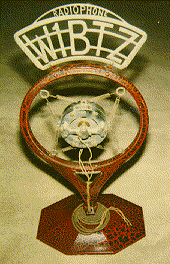
The development of the vacuum tube helped with improving volume in devices that were coming of age in the early 1900s.
The Condenser microphone was invented in 1916, and in 1928 George Neumann developed his first Condenser commercial microphone in Germany. The famous company is still the leader in recording instruments today. Noted as the Best mic in the World by more than a few.
In 1931 General Electric introduced the first Dynamic microphone, and the Ribbon mic in the early 1940s was developed to improve radio broadcast quality.
These types of radio microphones are popular and still in use today.
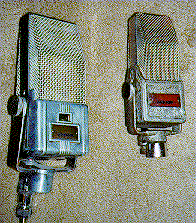
The Ribbon microphone was used during the war and was a favorite for early recording engineers who favored them.
The first directional microphone was a Unidirectional mic that was designed to collect sound from the top of the microphone.
This would set a new level of design for microphones in the future.
By the 1960s, smaller, more versatile microphones made their way on the scene called the electroacoustic transducer, an electret microphone. It transcended the radio microphone to become an affordable high, precision instrument built for the masses. Almost a billion microphones are made a year.
Uses of Microphones
The 1970s saw the advancement of the Dynamic and Condenser microphone with lower sensitivity to create even higher excellence in sound recording. Sennheiser developed the first clip-on microphone, which was a directional mic designed for recording studios.
The radio microphone and the radio are intertwined as far as inventions are related to one another. Some inventions that were produced, such as the telephone and the radio, needed the microphone for transmitting acoustical sound waves like the human voice through electrical systems to be picked up somewhere else and transmitted back from electrical signals to acoustical sound.
The Best Mics for Radio Broadcasting Use
Microphones can be high performers in part of Broadcasting or recording and not reliable in other forms of the industry. Large Diaphragm Condenser mics are produced with a low tone of the male voice in mind. Lower frequencies come from a bass guitar or a deep male voice.
The midsized diaphragm mics that can broadcast at higher EQ levels are engineered for women’s voices or cymbals and the higher frequencies of an acoustic guitar.
Dynamic microphones are popular in Broadcasting because of a few different reasons. One is power, the fact that Condensers need Phantom power to run and Dynamic mic doesn’t. Another reason is the Proximity effect that Condensers have can make the audio sound boomy, which can have a negative effect on the radio stations.
Dynamic microphones have fewer internal electronics and are less prone to overloads and distortion. Dynamic mics can handle more load in volume levels. Therefore, they can produce without problems and are better suited for the less controlled area of a radio station. Dynamic mics also have a greater resistance to ambient noise. This is a real advantage in radio and broadcasting studios that often have more unexpected stray and ambient noise than post-production studios.
Cardioid Dynamic mics have less off-axis noise that may happen from the background, handling them, and other higher limits from vibration that will cause disturbing interruptions. They generally are built for wide frequency response and are mechanically better built than other types of microphones.
Microphone Types and Characteristics
A Broadcasting Standard for many years is RE20 Broadcast Announcer Microphone with Variable-D from Electro-Voice. This radio microphone is a Cardioid microphone with exceptional clarity and low noise performance.
Response tailored especially for vocals with high sound pressure handling capabilities. It contains a Super-cardioid to prevent background noise from being picked up. It has a flatter response for less noise, and the proximity effect in the variable D technology is almost nonexistent.
The mic also has a humbucking coil that provides additional protection against hum caused by electrical equipment or bad grounding. This mic has an external pop filter and a shock mount that is dedicated to the microphone. RE 20 is one of the oldest and most widely used mics.
D technology is a technology that stabilizes the tonal effect throughout the extended working distance. The By-product effect of a Cardioid microphone is a Proximity Effect. In other words, Boom Noise.
Omni-Directional mics are used for interviews by broadcasters because they stay consistent with Tonal and Proximity Effects.
Any microphone that carries the Variable-D classification (meaning distance from the mic) Keeps the Tonal & Proximity from a Cardioid unidirectional mics from changing with any type of microphone, making them very popular in Broadcasting.

These microphones are outstanding in the studio and out in the field where a one-on-one interview where a Cardioid mic is needed or a group interview where an Omni-Directional mic might be consistent like this excellent Audix M1255B Miniaturized Condenser Microphone Omni Standard
Another is the Cardioid Directional position Rode Broadcaster microphone which is a large Gold Plated Diaphragm Condenser Mic that is suited for voice-over effect. It has an emphasized Proximity Effect and internal Pop filter to minimize plosive sounds.
In a 20 Hz-20 kHz response, and a selectable high-pass filter at 75 Hz is available to prevent low-end noise, such as air conditioners and traffic, from being recorded.
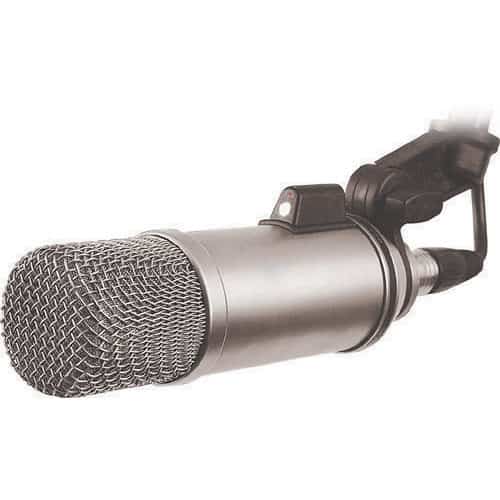
The Broadcaster features an ‘On-Air’ indicator on the body that can be wired for external activation by the Channel On/Off function on many consoles. If not connected to a console or switch, the indicator will stay lit whenever the microphone is powered up.
The Shure SM 7B is a Large Diaphragm Dynamic microphone that is used in Voice-over and Broadcasting This mic carries a flat wide range frequency that enhances mid-range and higher frequencies. This mid-range priced mic can be used for other applications besides Broadcasting like snare and drum work.
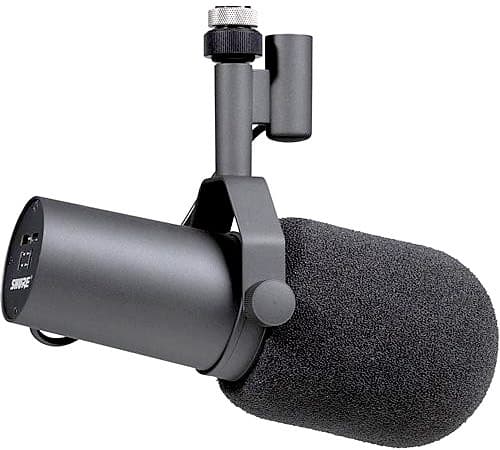
Like all Dynamic mics, it will require some gain, so a pre-amp is in order. The Shure 57 and 58 can be used for the vocal broadcast specialty. They both have a large diaphragm that is important for vocal reproduction. They have switches for Bass Roll-Off and mid-range enhancement that lets you tailor your own time.
One of the most common accessories found in a radio station where there is a televised picture of the operating room is a Boom arm that is attached to a Broadcasting microphone.
On the Air Microphone
This type of Boom Arm that is found in most radio broadcasts or Television Studios is attached to tables and suspends the mic in front of the speaker’s face. This isolates the mic and does away with unwanted handling and interference.
Microphones Used in TV Broadcasting
Major Microphone Designs used in Broadcasting are:
- Hand-Held– The type held by the Announcer on camera or interviewing someone on the camera, such as a locker room interview after a basketball or football game.
- lavaliere/clip-on mic) that is referred to as a personal mic. Usually hangs around the Broadcaster’s neck or clipped onto his/her clothing
- Shotgun-Used on location to pick up sounds from a moderate distance from the camera.
- Boundary Effects Miv is usually called a PZ or a PZM mic these depend mostly on reflective sound from a hard surface such as a tabletop.
- Contact Mics-That pick-up sound from direct physical contact with the sound source. These microphones are generally used on musical instruments.
- Studio Microphones– These are the largest group or category of microphones.
As we discussed earlier Dynamic mics are generally used in the field where a wide variety of difficulties could occur. When the small size and rugged construction, no power is needed Dynamic mics are used, the Condenser mic can be miniature in size and with better audio quality but are sensitive to the environment where they are operating.
Ribbon mics are still used in the Broadcast booth but are also subject to climate and temperature conditions. Contact microphones used on musical instruments have the advantage of eliminating outside external noise that can affect the Broadcast.
They have flat sides that make them recognizable in comparison to other small mics. In most video and Broadcast work, it is almost always desirable to use some form of Directional mic. They will reduce or eliminate unwanted noise from behind the camera.

Special Microphones
In radio interviews, the preferred mic is a Bidirectional microphone, or Bipolar type pattern comes from that comes from two directions or Handheld Cardioid that can be controlled by the interviewer and the subject being interviewed.
Could shotgun mics, with their hyper-cardioid polar patterns of acceptance, represent one of the most widely used types of mics for on-location video and TV work?
Since they are quite directional, they provide good pickup when used at a distance of 7-13 feet from the subject. Like other types of directional microphones, they tend to reject sound that would interfere with the on-camera subject of the interview.
Highly directional mics should not be used close to talent because they exaggerate bass. In addition to on-location settings, they are useful in stage and PA applications where amplified speakers are being used because they can deliver higher audio levels before feedback starts.
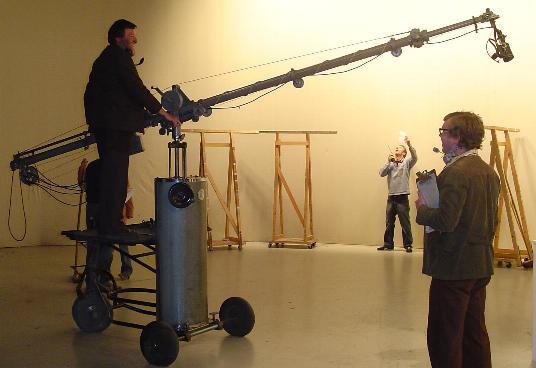
Shotgun Mics using Hypercardioid should not be too close. Otherwise, exaggerated bass and low end would happen in the Proximity Effect. They are useful on Stage, in TV production Studios, and in PA applications where amplified speakers are being used in areas where higher audio levels could cause feedback problems.
Parabolic microphones are the most highly directional type of mic application. This category refers more to the application of the microphone rather than the directional pattern of the microphone.
The Parabolic Microphone can be 1-3 feet in diameter, and you see them in Football TV telecasts and some other sports where the sport is played on large fields or tracks, as in NASCAR
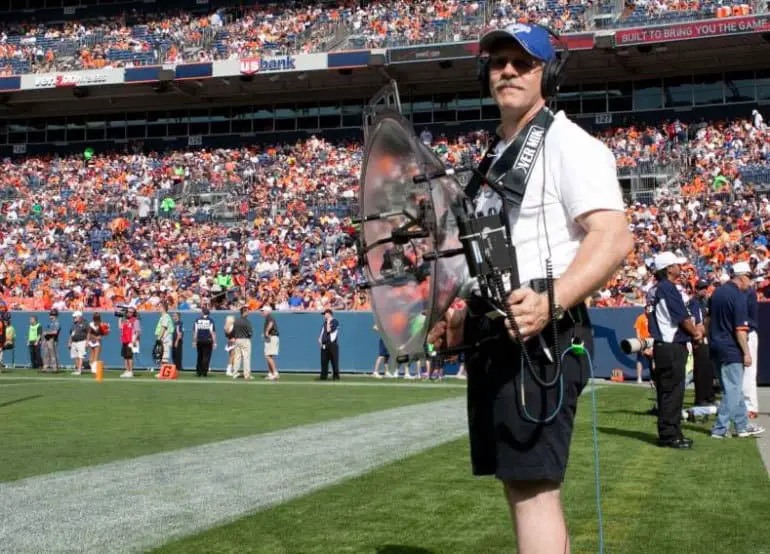
Because of the shape of the reflector, all sound along a very narrow angle of acceptance is directed into the microphone at the center. Parabolic microphones can pick up sound at distances of more than 60 meters (200 or more feet). These mics are not practical for general field production work, but they are often used in sports.
Best Microphone Used For Podcasting
The Podcasting microphone is broken down into 3 levels because of the interest in Podcasting and the new equipment available. it is advised that users new to the game use cheaper microphones. The first level is beginner or Entry Level:
Entry Level Podcasting Mic
Samson’s Q2U meets both your digital and analog audio reproduction needs in one convenient package, including the mic itself and all the accessories you need to start recording right out of the gate. The Q2U dynamic handheld microphone features both XLR and USB outputs, making it ideal for home/studio and mobile recording, as well as stage performance.
The mic is a cardioid type (unidirectional) pickup pattern, high-quality A/D converter with a 16-bit, 48kHz sampling rate and 50Hz–15kHz frequency response to ensure that the audio captured on stage, in studios, or on the go is clear, detailed, and accurate.
It’s also compatible with most computer-based digital audio workstations, so your recordings can be developed with enhanced control and functionality. It has a plug-and-play capability and doesn’t use a Driver installation. It will work with your camera with the adapter. With no-latency monitoring during recording- nice price for a lot of mics. Check Amazon for the latest price.
Podcasting Microphone
The Aussies have done it again with Rode Podcaster that we looked at earlier for a Mid-range price Broadcasting mic is also recommended for use in Podcasting. Ithe USB alternative is an excellent Dynamic Microphone. It will provide Broadcast quality with the simplicity of a USB connection.
You won’t need a Digital interface it can connect directly to your laptop.
18-bit resolution, 48kHz sampling A/D converter, the Podcaster processes all of the analog-to-digital conversion internally, bypassing the computer’s lower quality on-board sound controller altogether.
The Podcaster is ideal for podcasting, vodcasting, YouTube videos, voice recognition software, corporate videos, and any production application that requires a simple yet professional voice-over microphone. You can also use it to cut demos. The price is really easy for such a fine audio product. Check Amazon for the Rode Podcaster updated price and more information.
Pro-Level Podcasting Microphone
The Heil PR40 is being raved as the Podcaster’s mic that is the Go to Mic.
Heil Sound PR 40 Dynamic Cardioid Studio Microphone Bundle with PRSM Shock Mount, Two-Section Broadcast Arm, and Microphone Cable.
The HeilPR40 is a high-performance dynamic microphone ideal for use as a vocal mic for talk show hosts and other voice-over applications.
The champagne PRSM Shock Mount from Heil Sound is a flexible microphone support system that helps suppress low-frequency rumbles by absorbing vibrations. I have not heard of this mic, but it has great reviews from podcasters. Check with Amazon for an updated price.
Audix SCX1-HC Microphone
- Polar Pattern: Hypercardioid
- Frequency Response: 40Hz-20kHz
- Impedance: 150 ohms
- mV/Pascal Sensitivity: 28 mV
- Rejection Off-Axis: >15 dB
The SCX1-HC is a high-quality transformerless studio condenser. The SCX1-HC provides an exceptionally flat response, making it perfect for any ultra-critical recording or live sound application. The mic is extremely quiet, making it ideal for critical digital or analog recording.
It operates on standard phantom power of 48-52 volts DC. The SCX1-HC is a high-quality USA-made condenser comparable to the very finest European condenser microphones, which incorporate Surface Mount Technology (SMT).SpecificationsPolar Pattern: HypercardioidFrequency Response: 40Hz-20kHzImpedance: 150 ohmsmV/Pascal Sensitivity: 28 mVRejection Off-Axis: >15 dB max SPL: 130 dB
This is another mic that gets good reviews from Customers that are Podcasters. Podcasters are not in the limelight when it comes to reviews on music recording equipment. The podcaster is sort of in another world when it comes to audio equipment.
Some of the reviews that I read sound like “you can’t control the echo when your in a hard room with hard furniture” “Good mic with a good sound. The only Inside mic I ever liked for less than 1000 dollars” Or this one. “The only thing I can say that is a Con is that it comes with a noise but thats nothing that can’t be removed” Podcaster are nice people. Musicians are a little more demanding with their purchased equipment. I know I’ve been there.
JimGalloway Author/Editor
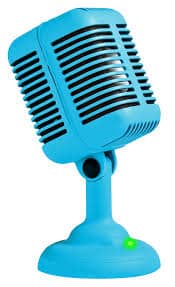
MikingDesign.com

